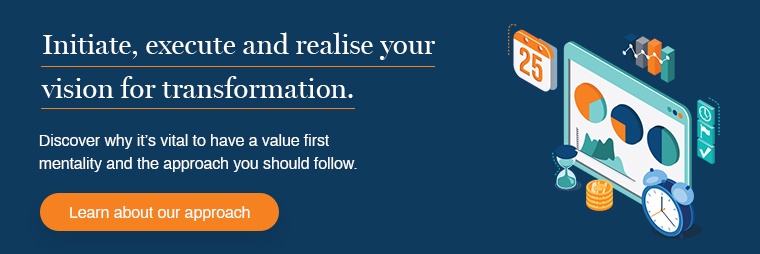Digital transformation is somewhat of a buzzword. Not only is it overused, but there’s confusion over what it actually means. This then leads to misconceptions which makes it harder for businesses to start their own digital transformation journey.
So, where should you really start? In episode six of the ColumbusCast podcast, I sit down with Business Transformation Principal Consultant Toby to demystify the ‘buzzword’.
Here’s a brief breakdown of what we discussed.
What’s the difference between change and transformation?
Change is taking existing processes or ways of working and modifying them in a way to improve them. Transformation, however, is taking what you already have in place and turning it on its head. It’s about transforming it to make it new (which then makes it better) so you can drive benefits and value that you’ve never had before.
In short, change improves value and transformation creates new value.
Are transformation projects more complex than change projects?
Not necessarily - it depends on the nature of the business and programme. What tends to happen is that the outcome of a transformation project causes more ripples throughout a business than a change project does. So, that’s where that misconception comes from.
 Photo by Leon
Photo by Leon
Capabilities matter
I always say it takes a different set of skills and capabilities to run a business than it does to change or transform one. That’s why it’s not so much the fact that a business is changing or transforming that makes the project complex.
Some changes can be quite simple and so can some transformations. Instead, it’s about the capabilities and competencies you’ve got within your team to make those changes.
People are a wildcard
One of the biggest challenges of a change or transformation project I’ve experienced is people. People and their motivations are a wildcard. You need to align mindsets, help them understand the reason for the change/transformation and keep them engaged throughout the project.
The success of a change or transformation project is underpinned by strong leadership
It’s a top-down directive. Change and transformation has to come from the leadership team. There must be:
- Determination to transform
- Recognition of a need to transform
- Knowledge of what you want to transform
- Knowledge of what you want to transform to
What is value?
 Photo by Redd
Photo by Redd
What value looks like will vary between businesses. Here’s the point where I should add that value doesn’t have to be monetary. Though things like improving cost efficiency will likely be important to you, you should also consider areas such as:
- Improved user experience
- Improved process efficiency
- Improved morale (as processes are simpler/more streamlined, tasks are easier to complete)
- Evergreen business applications
- Happier customers (higher Net Promoter Scores)
In short, value is something (or several things) that are perceived as beneficial by stakeholders - internal and external.
- Customer
- Organisation
- Employees
Get a good cross-section of stakeholder value (financial and non-financial) and you’ve got a great case for transformation.
Where can you find value?
When you’re undertaking a change or transformation programme, look for where you can find new value. As well as looking at what you’re doing well, look at where you’re not doing as well.
- Where are people struggling in?
- Where are the inefficiencies?
Once you’ve identified your business challenges and opportunities, quantify the impact of those. This is part of Columbus’ value first offering. It’s easy to say that a particular system isn’t user friendly or it’s difficult to extract data. But what is the true impact of that?
At Columbus, we help to score the impact of that issue and recognise its priority against your other business priorities. This helps you better understand value in terms of short-term value gain, long-term value gain and everything in between.
That will help you phase the programme so you can achieve what you want to achieve within your intended timeframe (and budget). We’re actually offering a FREE taster session where we'll show you a key part of our Value First approach. We will help you build a clear vision, plan priorities and create a proposition for your change initiative.
Find out more about it via the button below.
If you want to change or transform, value is everything
In addition to the above, we also debate why a mere 30% of transformations succeed in delivering the value they were aiming for and the tools businesses need to improve, increase or create new value.
Scroll up to the top of this post to listen to our episode or search for ‘ColumbusCast’ in your podcast app.
Learn more about the value first approach you should follow
Value is something we’ve talked about all the way through this post and in our podcast. Want to learn more? We actually have a value first approach - that we created - which outlines the key steps you must follow to ensure successful value management.
Find out more about the approach by downloading the brochure.


